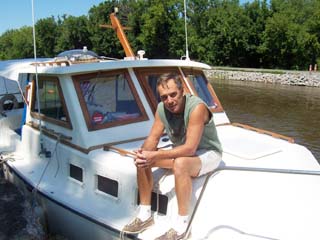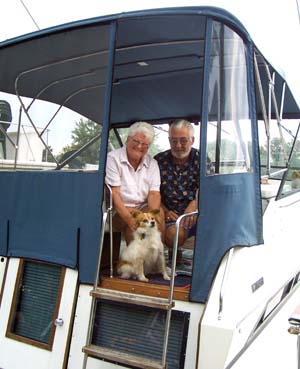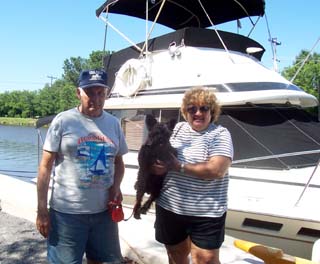
|
Traveling the Erie Canal
When the first shovelful of dirt was turned on July 4, 1817, the country's forefathers likely never imagined that "Clinton's Ditch" would turn into the tourist route that it has become in recent years. It was originally dug as a way to bypass the undependable streams and rivers that thwarted businessmen and farmers who needed to transport their goods. When the country was young, dependable transportation was needed to move food, grain and natural resources across the still wild and rugged Western New York and then mayor of New York City, DeWitt Clinton, championed the idea of digging the 363-mile long Erie Canal. In October 1825, the canal was finished and Governor Clinton left Buffalo for the inaugural "tourist" trip that ended in New York City with the governor symbolically wedding the waters of Lake Erie to the Hudson River. Since that first journey, the idea of canal travel has ranged from slow barges filled with food, hauled by mules, to the tourist destination it has become today with boats of all descriptions making their way along the scenic route. State officials have been funneling funds into the revitalization of both the canal and the towns that border it in an effort to boost tourism. The effort is bearing fruit as canal travel has become in vogue, from day cruises sponsored by the various towns that front the historic Erie Canal to individuals and families who pack up, fuel up the boat and spend anywhere from weeks to months traversing its gentle waterways
Part of the allure of a canal trip may be the slow going. The speed limit along most stretches is a leisurely 10 miles per hour - a far cry from the hectic pace of normal daily living. Surely the pace is part of the charm - a tranquil contrast from our fast-paced lives. For Dennis and Esther Bruckel, spending six months of the year on the water is simply a way of life. They are originally from Northern Vermont where the couple owned and operated a nursery/garden center. They sold the business close to seven years ago and have been traveling ever since. "We kind of bought a boat by accident, then our plans evolved around the boat," Dennis said. "Because of the seasonal nature of the garden center, we would take the winter off and travel to warmer climates." Dennis's "better half" was not on board the day I met with him. "She's finishing up a two week trip to Scotland," he explained. "This has been the longest that we have been apart on the boat and I am starting to miss having her here." She was due back later in the week, he said. For Bob and Kathy Hadlock of Greece, the lure of canal travel is based on the slower speed of life on a canal as well as the fact that bad weather doesn't slow them down. "We never have to contend with waves like we would if we were in open water," Bob said. "If it starts to rain we just zip up the sides, turn on the windshield wipers and keep going." The Hadlocks say they likely log 500 miles a year along the canal's waterways. "We put the boat in the day the canal opens in May and we keep it in until the canal closes in November," they said. "We've been traveling the canal for the past eight years and we aren't bored yet. There is something new every time we go out.
The Bruckels have logged 40,000 miles - or 7,000 engine hours - on their 1984 Albin 27 foot long boat. "This is about as small a boat as you want to spend six months aboard," Dennis said, comparing the vessel to traveling in a pop up camper rather than a recreational vehicle. While on board their boat, the Sadie B, the couple enjoy everything they need from cooking to sleeping to entertainment, they spend most days and nights on the boat. "The only time we really don't spend on board is when we are either at boat shows, or if we are in the middle of a hurricane - we might go ashore and stay in a hotel," he said. But, Dennis added, they were in New Jersey and the eye of a hurricane passed over them. "Depending on where we are anchored, it's sometimes better to just stay aboard." The Hadlocks echo the sentiments that they could cook aboard their 36 foot Trojan. "Sure we could cook on board," Kay said. "We have a microwave and a stove but we like to eat out at restaurants along the way. We have made some amazing discoveries during our travels through the canal towns." When the Hadlocks pack up and head out for a vacation cruise along the canal, they are not alone. They have their 10-year old Papillion, Skipper with them. "Skipper knows that when the engine turns on it is trip time," Kay said. "He has been on a boat all of his life." What happens when the dog hears nature calling him? Well, the Hadlocks say, they simply pull over to a grassy spot on the canal side and take him for a walk. While on board, Skipper normally reclines on one of the padded seats by the captain's chair and takes in the sights and sounds of the canal life, they said. With a daughter and three grandchildren on shore, Dennis said they try to take at least one of the grandchildren with them for a couple of weeks out of the summer. And while for six months of the year the Bruckels call the waterways home, when they anchor the boat for the season, they call Florida home. James and Marian Baer and their dog, Spencer, enjoy two week vacations aboard their 32 foot Trojan. "Every year we leave home and spend about 10 days on the boat," Marian said. They have boating in their blood, they said, as they have owned vessels of varying sizes for more than 50 years. "We started out small and worked our way to this cruiser," James said. Friendly folk Boaters appear to be a friendly lot because prior to this writer's interviewing Dennis on board, he has been visiting with a mother and her daughter who were enjoying one of the rare sunny days to hit Western New York this summer. He was docked in Holley and had just taken advantage of the shower facilities the village recently constructed. Kay said one of her favorite parts of traveling the canal is the friendly people they meet. "Whether we meet people from other boats or people in the towns where we stop, they are just all friendly," she said.
The Bruckels, among many other boaters, have discovered the beauty and tranquility that is the Erie Canal. "The Erie is under-traveled in some areas," he said. "I think the canal is one of America's most undiscovered, best kept secrets." For an annual fee that ranges from $75 to $100, depending on the length of the vessel, boaters can travel one end of the canal to the other. "We can use it (the canal) all summer for that one fee," Dennis said. It's the social aspect of boating that lures the Baers. "We have met some great people while we've been out," Marian said. For James, the history and scenery of the Erie Canal are what draws him back every year. When I caught up with them, they were docked in Brockport enjoying a respite on shore. They were sitting in lawn chairs on the bank while Spencer frolicked at their feet. Many of the ports along the way offer such amenities as electric and water hook ups and still others have boat houses with shower, bathroom and laundry facilities. "We can take a shower on the boat but it is a very small space," Dennis said. "After six months on the water we are ready to head inland but then after six months in Florida we are ready to get back out (on the water)." In addition to enjoying retirement and cruising the Erie and traversing the Great Loop, Dennis is the program coordinator for Trawler Fest, an organization that produces events that combine a traditional boat show with educational sessions. "We kind of encourage social networking with other long range cruisers," he said. Bob said he can really see the efforts the state has put into canal revitalization. "They are just doing a great job," he said. "Every time we go out I see improvements in each town and village along the way. The state is making it great for boaters and bicyclists." Along the way "Serendipity happens" while cruising the canal, Dennis said. "Sometimes we run across little carnivals or festivals in the towns we are passing through." As for the Baers, they occasionally plan their travel around various festivities but for the most part, they just pack up their supplies and head out from their North Tonawanda home. "We don't normally have a set destination, we just get in and go," Marian said. James said it takes about four-and-a-half hours to get from Middleport to Brockport and that they usually put in nine-hour days before finding a place to dock for the night. Next year, the Baers are hoping to make a trip up the canal to Oneida Lake. "I think we will probably be gone for about three weeks that trip," James said. While the Hadlocks don't make very many firm plans when it comes to their trips, they do schedule some to coincide with the various festivals along the way. "We usually try to hit as many festivals as we can," Kay said. "We usually dock a day or two early just to make sure we can find a space." Skipper Bob For many who travel the waterways, the name Skipper Bob is synonymous with published travel guides. Skipper Bob has cruised more than 44,000 miles on the East Coast of the United States. He is also the author of a guide on cruising the New York canal system that details depth and height restrictions, offers lock locations and characteristics and information on where travelers can stop. His publication, Dennis Bruckel said, is one he and his wife have on board at all times. "In addition to offering information on historical sites and places to shop, the guide tells which towns or villages offer various amenities and if there are charges for their use," he said. The Bruckels' copy of the guide showed signs of wear and tear from its use and also included penned in updates they had added to the book along their journey. "I just updated the information about Holley and its updated facilities," he said. A brief history lesson It was August 1802 when the first swing of an ax felled a tree on a spot that would eventually become the Village of Spencerport. George Warren Willey, the first white man to build a home, had made his way - on foot - to this wilderness area from Connecticut. But it was Austin Spencer for whose family the village is now named. He came to the area in 1808. Brockport, now a bustling village, had its humble beginnings as a wide spot in a path running north from Batavia to Lake Ontario. The first settlers in Brockport landed in 1804. It was in 1822 when the Canal Commission decided to build the canal that James Seymour and his partner, Hiel Brockway, bought up some land and laid out the village. The Village of Holley, in the Town of Murray, also owes its existence to the Erie Canal. The village was originally covered with a heavy growth of Hemlock trees. Once the trees were cleared, a vigorous settlement developed. Areovester Hamlin took up 100 acres of land, which included most of the present village of Holley, in about 1820, and immediately commenced clearing off the timber and laid out the village. The canal's 'ghost towns' Along with the prosperous villages and towns that sprouted up along the banks of the newly constructed Erie Canal, Orleans County can count at least two ghost towns - hamlets borne of the canal that also died because of it. A canal trip that goes down Hindsburg or Gaines Basin Roads will have the traveler passing through areas that many years ago were bustling canal ports. Where there once were hotels, grain warehouses, general stores, various other mercantile businesses and homes, there are now only shadowy reminders and streets named after long-gone hamlets. Orleans' ghost towns prospered when the mule drawn conveyances could cover 15 miles a day. Upon the completion of the canal, larger tugs and barges didn't need the respite that Hindsburg and Gaines Basin offered and the towns eventually disappeared. More information: Trawler Fest www.trawlerfest.com skipper Bob |


